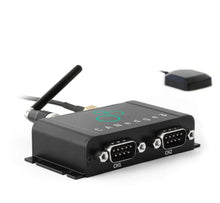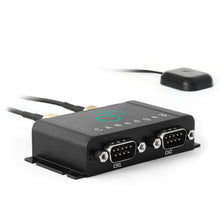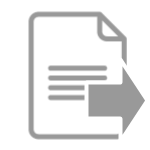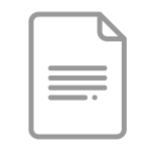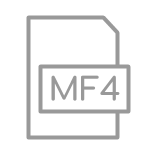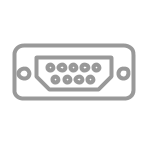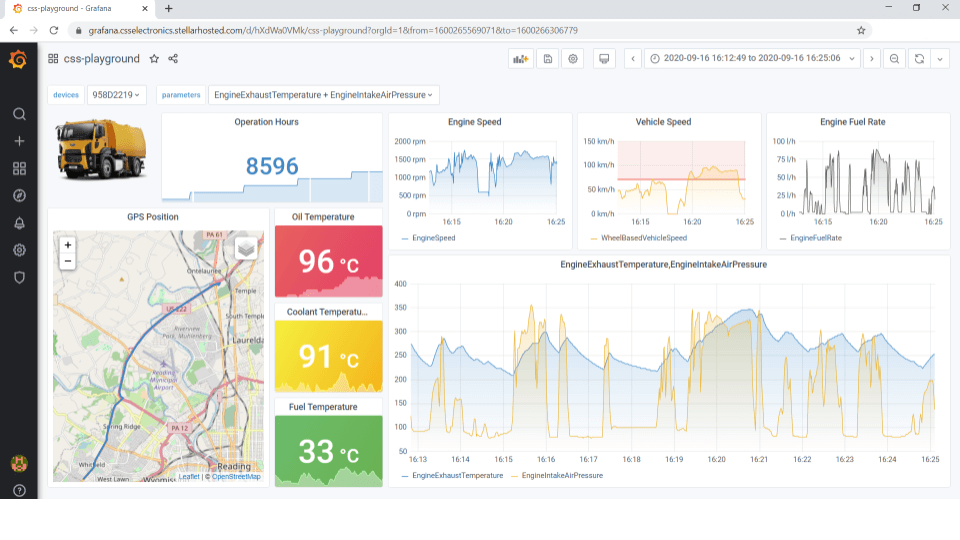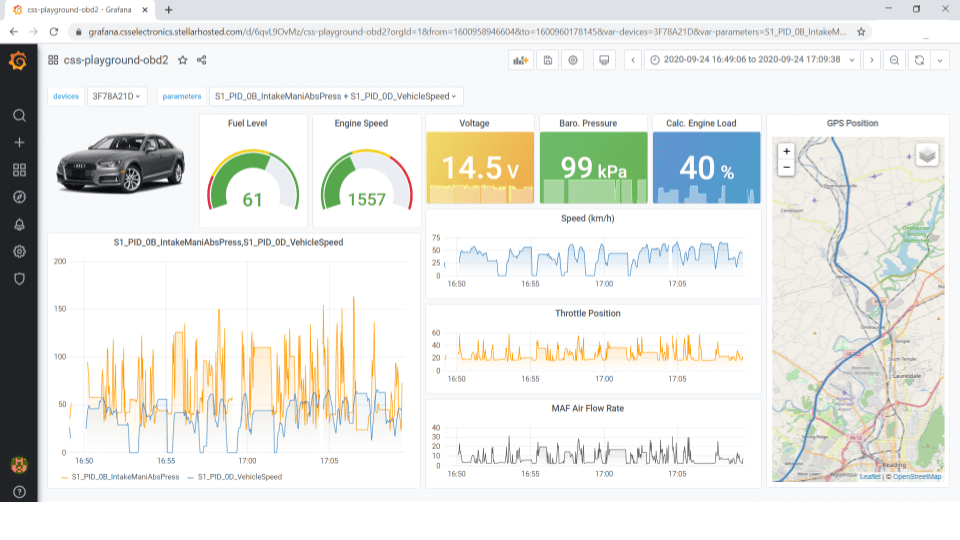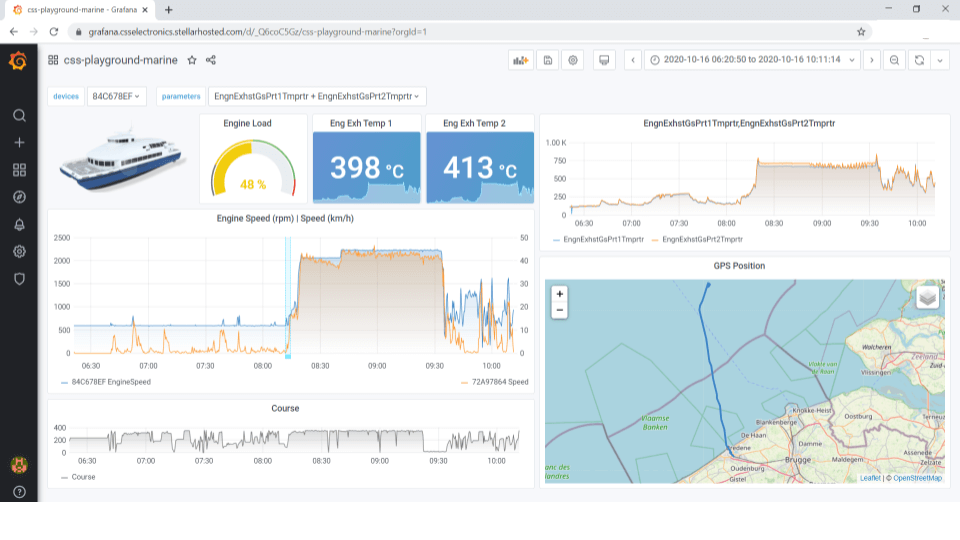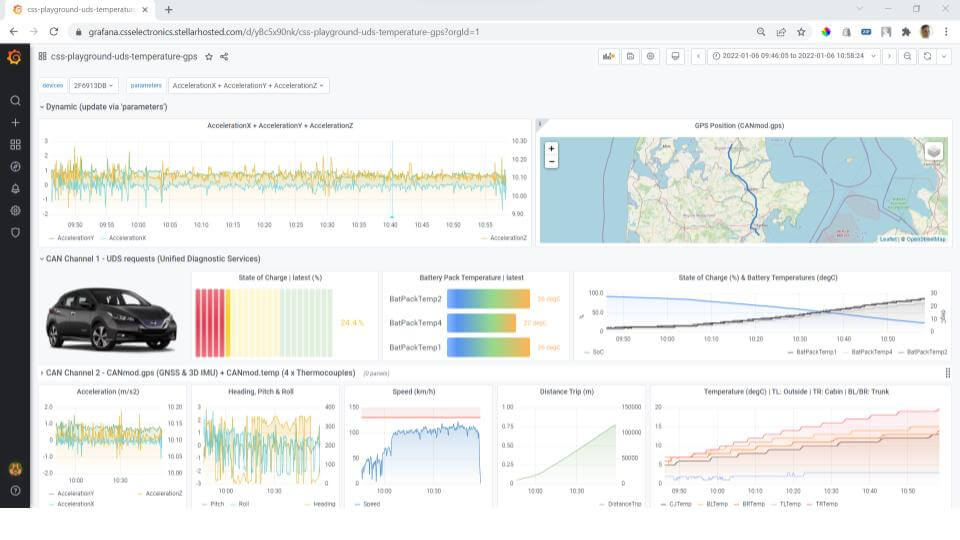Log data out-the-box. Standalone. Link your CAN bus to your server in <2 mins
Only 8 x 5 x 2 CM. 100G. Aluminium enclosure. 6 LEDs. Configurable 5V power out (CH2)
Built-in GNSS/IMU. 3x accuracy via sensor fusion. Position, speed, acceleration & more
Pro specs CAN logger
- at half the cost
The CANedge3 combines innovative design, cutting-edge components - and incredibly low costs:
- 2 x CAN (incl. CAN FD) + 2 x LIN channels
- Extractable 8-32 GB industrial SD card (= months of data)
- Popular binary MDF4 log file format
- Advanced message filtering & transmit functionality
- Route data from CAN1/2, LIN1/2 and GPS/IMU onto CAN1/2
- Start/stop logging triggers based on CAN ID & databytes
- Silent mode, bit rate auto-detection, cyclic logging
- Data compression & encryption (e.g. for GDPR, CCPA)
- Support for CAN/LIN error frame logging
- Fast boot time. Safely disconnect during use (power safe)
- Add CANmod to e.g. log 5 x CAN or temperature/analog data
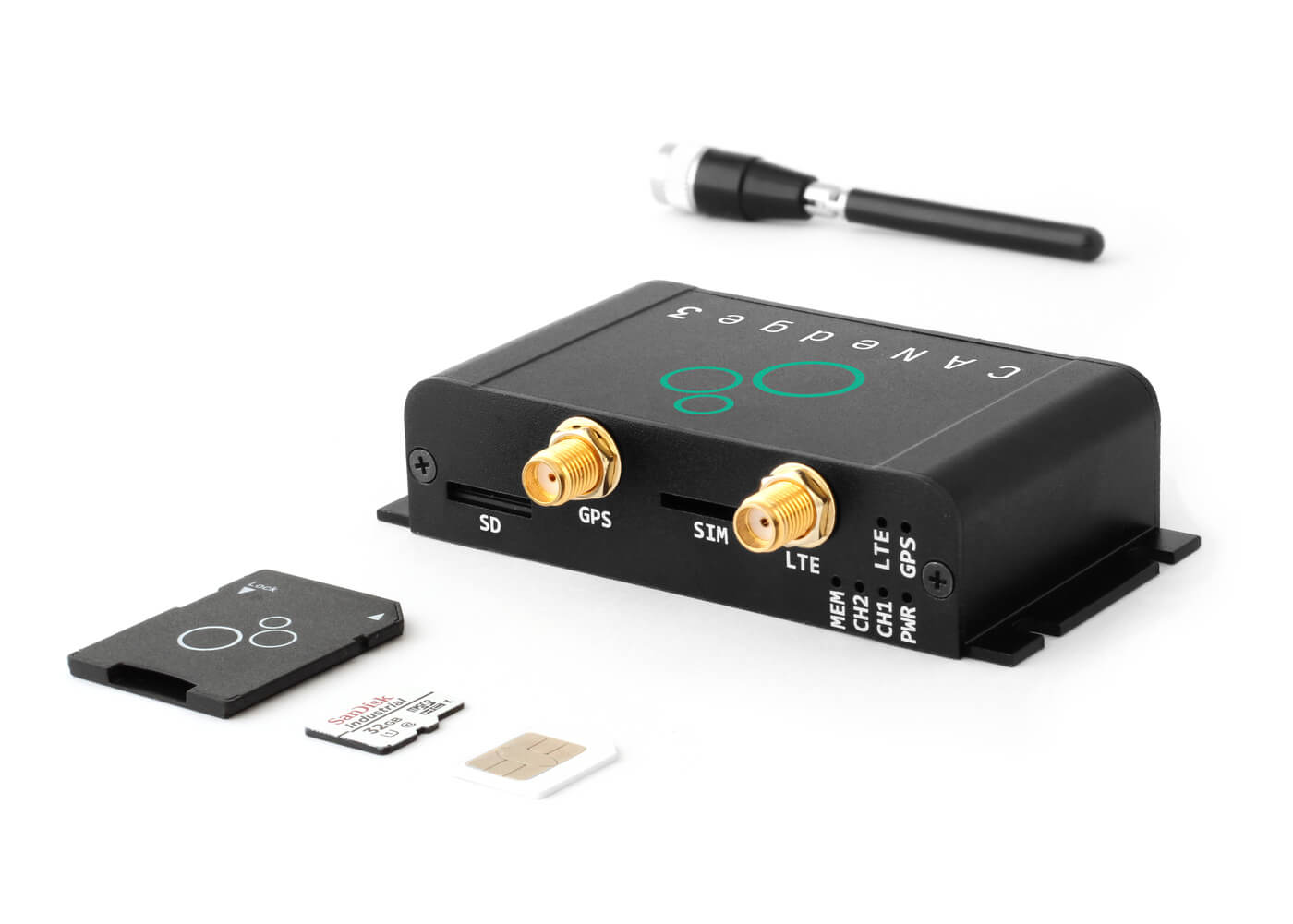
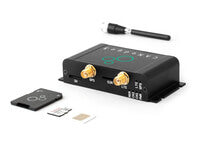
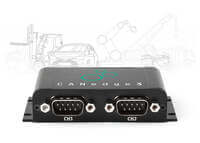
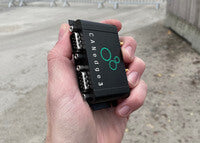
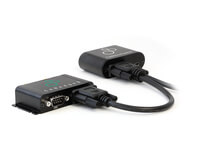
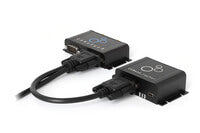
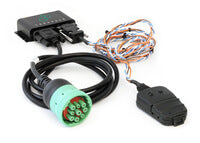
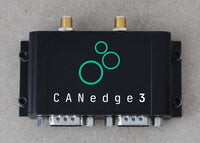
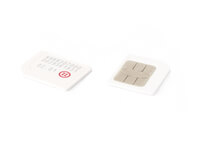
Reinventing telematics
Today, fleet telematics is vital across vehicles and machines.
However, end users face challenges: Expensive subscriptions. No data ownership. Security concerns. Vendor lock-in.
The CANedge3 provides a modern alternative:
- Log data to the SD and auto-upload via global 3G/4G
- Use your own server (self-hosted or cloud)
- Use your own SIM (or 90% discounted Super SIM)
- Simply add your SIM/server details to the config
- Configure file split size/period to control upload frequency
- 100% secure: HTTPS, credential encryption and more
- Manage via over-the-air updates (firmware & configuration)
- Zero fees. Zero lock-in. Interoperable. Open source tools
The CANedge3 has a built-in SIM card slot for use with external micro SIM cards.
You can use any compatible SIM card with the device (see the frequency bands for compatibility), meaning that you can source your own micro SIM cards and insert these into the device. By providing the relevant APN details in the Configuration File, you'll then be able to quickly setup the CANedge3 3G/4G LTE functionality.
However, for convenience, every CANedge3 comes with an optional SIM card included. This SIM card is a Super SIM which offers a number of benefits:
- You avoid sourcing a physical SIM card
- You can quickly activate the SIM (see the CANedge3 Intro)
- You benefit from 60-90% lower data rates vs. normal
- For larger batches, you can order pre-configured devices for plug & play connectivity
Importantly, CSS Electronics is not involved in the data transfer payments for the Super SIM and we gain no share in these payments. We purely offer this as a 100% optional way for our end users to quickly connect devices with minimum hassle. Further, due to the global volume of CANedge3 units deployed, you'll benefit from our negotiated 60-90% reduction in data rate costs - even if you just have one CANedge3 device. If you decide to use the Super SIM card, you'll create an account with KORE, register your SIM cards to the account - and contact KORE to apply the account-level discount. We guide you through this step-by-step in the CANedge3 Intro
GPS & 3D IMU - enrich your data
The CANedge3 comes with cutting-edge GNSS/IMU functionality - perfect for use cases like vehicle telematics.
- Add 40+ GNSS/IMU signals to your 2 x CAN/LIN data
- Full GNSS support (GPS, Galileo, BeiDou, GLONASS)
- Built-in gyroscope (roll, pitch, yaw) and accelerometer (X, Y, Z)
- High precision via sensor fusion - even in GNSS hostile areas
- Signals encoded as 'internal' CAN frames (separate channel)
- Configurable message inclusion/frequency (up to 5 Hz)
- DBC file included for easy decoding to human-readable form
- Optionally sync the CANedge RTC via precise GNSS time
- Flexible deployment via external GNSS or LTE/GNSS antenna
Position + sensor fusion
Add time-synced GPS positioning to your CAN/LIN data - with sensor fusion (UDR) for 3x higher accuracy.
Speed
Speed data is useful in e.g. fleet telematics to identify speeding, idle time, asset utilization rates and more.
Altitude
Altitude is key in e.g. analysis of fuel/battery consumption - or e.g. in aerospace applications like drones, planes etc.
Attitude
The GNSS/IMU enables attitude data, giving a 3D view of the asset orientation at any time [automotives].
Trip distance
Trip odometer data enables easy tracking of the trip distance travelled by the asset (since last module power cycle).
Angular rates
3D IMU angular rates can be used in e.g. the analysis of driving and vehicle dynamics (tire/suspension, drifting, ...).
Acceleration rates
3D IMU acceleration rates can be used in e.g. analysis of driving quality and predictive maintenance.
Geofences
Configurable circular geofences are useful for e.g. theft prevention, safety, automation and more
Timestamp
The high precision epoch timestamp is useful e.g. in syncing the CANedge real-time clock.
Open source software/API
- naturally
The CANedge3 uses open formats (MDF4 data, JSON config, S3 server) - and all software/APIs are 100% free and open source.
The software toolbox includes:
- Editors: Easily modify your device config (online/offline)
- CANcloud: Manage connected CANedge3 devices & data
- S3 drive: Mount your S3 server as a 'local drive'
- Converters: Convert data to Vector ASC, PEAK TRC, CSV, ...
- asammdf GUI: DBC decode, plot and export your data
- Python API: Automate your data processing & integrations
- Dashboards: Visualize data in custom browser dashboards
Check out our tech specs, use cases or FAQ - or buy now!
Do you have any questions?
Contact us| GENERAL | |
|---|---|
| Functionality | Standalone CAN bus data logger with SD card, 2xCAN/LIN channels, 3G/4G LTE and GNSS/IMU |
| Firmware | Supports free firmware updates for adding features |
| Configuration | Configuration files based on the popular open source JSON schema concept |
| Software | Free open source editor tool for easy device configuration (offline/online version available) |
| Free open source CANcloud telematics platform for managing devices & data via your browser | |
| Multiple tools for mounting your S3 server as a local drive for easy access | |
| Free open source asammdf software & API for editing, DBC converting & plotting MF4 data | |
| Free open source MF4 converters - drag & drop log files to convert into e.g. CSV, ASC, TRC | |
| Free open source Python API - e.g. for automated data processing, reporting or integrations | |
| Free open source telematics dashboards for visualizing your DBC decoded data in your browser | |
| Safety | CE-RED, FCC, IC, RoHS, ECE R10 (automotive EMC), RCM (Australia), ICASA (South Africa), KC (Korea) |
| Warranty | 1-year warranty |
| Support | Free, fast & high quality support |
| Origin | Denmark |
| CAN BUS | |
| Channels | 2 x CAN channels (incl. CAN FD support) |
| Standard | ISO 11898: Compliant with CAN (up to 1 Mbit/s) and ISO & Bosch CAN FD (up to 5 Mbit/s payload rate) |
| Protocols | Log raw data from CAN based protocols (J1939/FMS, CANopen, NMEA 2000, OBD2, CAN FD, UDS, ...) |
| Identifiers | Compliant with CAN specifications 2.0A (11-Bit ID) and 2.0B (29-Bit ID) |
| Bit-Rate Auto-Detect | Bit rate can be auto-detected or set manually |
| Retransmission | Configurable retransmission of frames that have lost arbitration or been disturbed by errors |
| Transceiver Protection | ±16 kV HBM ESD, ±15 kV IEC ESD, ±70 V bus fault, short circuit |
| Common mode input voltage: ±30 V | |
| TXD dominant timeout (prevents network blocking in the event of a failure) | |
| LIN BUS | |
| Channels | 2 x LIN channels |
| Publisher/Subscriber | Each LIN channel can be configured as a LIN subscriber/publisher with support for LIN data transmission |
| Custom length | Support for custom frame lengths |
| Standard | Compliant with LIN 2.0 up to 20 Kbit/s (support for Classic & Enhanced checksum format) |
| Transceiver Protection | ±8 kV HBM ESD, ±1.5 kV CDM, ±58 V bus fault |
| TXD dominant timeout (prevents network blocking in the event of a failure) | |
| DATA LOGGING | |
| SD Card | 8 GB extractable Class 10 industrial micro SD (SDHC) included (optional 32GB) - read at 80 MB/s
i
The device uses a class 10 industrial micro SD card with strong specs:
|
| Parallel CAN/LIN | Record data from up to 2 x CAN channels + 2 x LIN channels, simultaneously |
| Real-Time Clock | Yes - CAN frames are date & timestamped with 50 microsecond resolution (battery backup) |
| The RTC can be configured to match local time zones (default: UTC) | |
| The RTC can be auto-synced via 3G/4G LTE or a CAN message (e.g. from the internal GNSS timestamp) | |
| Log File Format | Log data in industry standard binary MF4 (easily convert to e.g. CSV, ASC, pandas, MATLAB, ...) |
| Data Compression | Configurable embedded log file compression (~50-80% size reduction) |
| Silent Mode | Configurable silent mode: Restricted (acknowledge only) or monitoring (zero transmission) |
| Filters | 128/64 regular/extended ID filters per channel (range, mask, acceptance, rejection) |
| Prescaling | Prescale CAN frames to record e.g. by time (per X ms) or by data (e.g. if byte X or Y changes) |
| Transmit | Transmit lists of CAN frames per channel (single-shot/periodic) - e.g. for OBD2/UDS/XCP requests |
| Gateway Routing | Data from CAN1/2, LIN1/2 and CAN9 (GPS/IMU) can be routed onto CAN1/2 (with optional ID re-mapping) |
| CAN Error Frames | Support for logging CAN error frames (bit-stuffing, form, CRC, bit, acknowledgement) |
| LIN Error Frames | Support for logging LIN error frames (checksum, receive, synchronization, transmission) |
| Remote Frames (RTR) | Support for logging/transmission of remote CAN frames (RTR) |
| Cyclic Logging | Optional cyclic logging mode (oldest log file is deleted when SD card is full) |
| Advanced Triggers | Control signal lets you start/stop logging based on custom CAN IDs & data thresholds |
| CAN Heartbeat | Optionally transmit heartbeat CAN frame with device status, storage used & RTC time |
| File Split | Configurable log file split size (by size: 1-512 MB and/or by time period: 0-86400s) |
| Power Safe | 100% power safe data logging - no file corruption when disconnected |
| Unique Device ID | Each device has a globally unique ID ensuring unique log file naming |
| Data Encryption | Log files can be encrypted at rest on the SD card for security/GDPR/CCPA (incl. integrity check) |
| 3G/4G LTE | |
| SIM Slot | SIM card slot for external micro SIM cards (mid size) |
| SIM Card | Use your own SIM card or activate the 'Super SIM' that ships with the device (with 60-90% discounted rates) |
| Note: Verizon SIM cards are not supported | |
| 3G/4G LTE Module | Professional-grade u-blox LARA-R6001D LTE Cat1 |
| Coverage | Global |
| Frequency (Bands) | 4G LTE FDD bands: 1, 2, 3, 4, 5, 7, 8, 12, 13, 18, 19, 20, 26, 28 |
| 4G LTE TDD bands: 38, 39, 40, 41 | |
| 3G bands: 1, 2, 5, 8 | |
| Frequency (MHz) | 4G LTE FDD: 700, 800, 850, 900, 1700, 1800, 1900, 2100, 2600 |
| 4G LTE TDD: 1900, 2300, 2600 | |
| 3G: 850, 900, 1900, 2100 | |
| Certifications | CANedge3: PTCRB (antenna >20 cm from device), AT&T |
| Protocol | HTTP/HTTPS: Stable and secure transfers - ideal for big data telematics |
| Over-The-Air (OTA) | Configuration & firmware over-the-air (COTA/FOTA). Configurable sync rate. Optionally disable |
| Heartbeat | If enabled, the CANedge3 periodically "checks-in" by uploading a small device status file |
| Data Upload State | Optionally disable/enable upload of log files (e.g. via over-the-air configuration) |
| Antenna | External (SMA). Can be extended or replaced by e.g. a 2-in-1 antenna (3G/4G LTE + GNSS) |
| S3 Server Interface | Upload data to your own cloud server (e.g. Amazon, Google, Azure) or self-hosted server (e.g. MinIO) |
| 3G/4G LTE SECURITY | |
| HTTPS | Data & over-the-air updates can be sent via HTTPS (TLS 1.2) for secure transfer to server |
| Credential Encryption | S3 server credentials can be encrypted in the config on the device SD card |
| Signed Firmware | Firmware updates are digitally signed to verify that they are from a trusted source |
| User Policies | Fully customize access rights across CANedge devices and end users through S3 policies |
| GNSS & 3D IMU | |
| Module | Professional-grade u-blox NEO-M9V sensor module (92-channel) with built-in gyroscope and accelerometer |
| GNSS | Supports combinations of GPS (USA), Galileo (Europe), BeiDou (China), GLONASS (Russia) |
| Sensor Fusion (UDR) | Enhanced position precision via sensor fusion (UDR) of GNSS and 3D IMU [automotives only] |
| Up to 3x better accuracy vs. GNSS-only receivers | |
| Extended and improved GNSS fix in GNSS hostile areas (e.g. urban environments, tunnels, ...) | |
| Accuracy | Position: 2.0 m CEP (Circular Error Probable) |
| Heading: 0.3 deg | Pitch: 0.4 deg | Roll: 0.6 deg (68% at 30 m/s) | |
| Velocity: 0.08 m/s | |
| Sensitivity | Tracking/Navigation: 160 dBm | Cold starts: 148 dBm |
| Acquisition | Cold start: ~30-120 seconds from device boot |
| GNSS Antenna | Required for GNSS-based data (not for IMU) |
| DATA PARAMETERS | |
| CAN encoding | The GNSS/IMU data is encoded as 'CAN messages' within the CANedge log files (on a separate channel) |
| Configuration | GNSS/IMU messages can be filtered/prescaled to enable custom message inclusion and frequency |
| Optionally record GNSS/IMU messages only if valid | |
| Signals | The module adds several GNSS/IMU signals (for a full list, see the Docs or DBC file) |
| GNSS position: Longitude and latitude information [5 Hz] | |
| GNSS time: Precise GNSS based epoch timestamp [5 Hz] | |
| GNSS status: Fix type (NO/UDR/2D/3D/GNSS+UDR) and satellite count [5 Hz] | |
| GNSS speed: Travel speed in m/s and km/h [5 Hz] | |
| GNSS altitude: Altitude in meters [5 Hz] | |
| Attitude/orientation: Roll, pitch, heading [automotives only] [5 Hz] | |
| GNSS odometer: Distance traveled (since power on) [5 Hz] | |
| 3D IMU: Accelerometer-based acceleration (X, Y, Z) [5 Hz] | |
| Geofences: Status of the configured geofences [5 Hz] | |
| ELECTRICAL | |
| Input Supply | +7V to +32V DC via the Channel 1 DB9 (e.g. from the vehicle/machine power supply) |
| Power Consumption | Very low (~1 W in normal operation, ~2.5 W during 3G/4G transfer) - no risk of battery drainage |
| Protection | Reverse voltage protection on CAN-bus supply |
| Transient voltage event protection on supply lines | |
| MECHANICAL | |
| Enclosure & Weight | Compact aluminium enclosure: 75 x 47 x 20 mm (W x L x H excl. flanges & antenna connector). 100 grams |
| Antennas | 3G/4G LTE antenna and GPS antenna included |
| Flanges | Flanges with 4 x M3 screw holes (head diameter < 6 mm) - see also the CANedge 'mounting kit' |
| Connector | 2 x Standard D-sub 9 (DB9) connectors (optional OBD2/J1939/... adapters) |
| Pin-Out | See the product manual for the DB9 connector pin-outs |
| Configurable Power Out | Channel 2 can be configured to supply 5V to external modules (e.g. the CANmod sensor-to-CAN modules) |
| LEDs | Logger status via 6 external LEDs: Power, CH1, CH2, Memory, LTE, GNSS |
| Temperature | Operating temperature (parts): -25degC to +70degC |
| IP Rating | IP Rating 40 (optional IP67 enclosure kit available) |
The CANedge3 is a powerful, standalone CAN logger for ad hoc analysis, diagnostics and development.
However, the device truly shines in e.g. fleet telematics and IoT machinery setups:
OEM prototype vehicle fleet telematics
Need to monitor prototype vehicles in the field?
As an automotive OEM, you'll often need to collect data across your prototype vehicles during field use. With the CANedge3 this is simple. First, set up e.g. an AWS S3 server (in < 5 min) - and configure the device with your server details. Next, connect the device to your vehicle to start logging and to auto-upload the log files via 3G/4G LTE. If needed, you can also transmit requests to enable logging of OBD2, UDS or CCP/XCP data. Further, you'll benefit from GNSS/IMU data with enhanced sensor fusion accuracy - adding signals like position, attitude, speed, distance, acceleration and more.
Predictive maintenance for heavy duty fleets
Need to implement practical vehicle fleet predictive maintenance?
The CANedge3 can be deployed across any CAN application - incl. trucks, buses, excavators, cranes and more. The device lets you log 2 x CAN (e.g. J1939) and request data such as DTCs. Data can be uploaded in near real-time to your own server for automated processing using e.g. our Python API. This lets you set up alerts and provide immediate insights to technicians on the vehicle status, position and more. See also our predictive maintenance case study (250+ assets).
Remote diagnostics for marine fleets
Need to monitor and remotely troublesheet issues for maritime vessels?
The CANedge3 is ideal for maritime telematics due to the combination of SD + 3G/4G LTE. The 2x CAN channels let you record e.g. J1939 engine data and NMEA 2000 data in parallel. The data can be accumulated on the SD while the vessel is at sea - and be auto-offloaded from the SD once the ship nears shore (within cellular coverage). With our J1939 DBC and NMEA 2000 DBC, you can easily decode the CAN data to physical values - and e.g. visualize it in Grafana dashboards. This enables quick visualization and easy alert automation for remote troubleshooting by e.g. maritime OEMs.
Monitoring remote industrial assets
Need to monitor remote assets for warranty/compliance?
For remote industrial assets like generators and solar/windmills, you may need to remotely monitor the asset performance, KPIs and DTCs. With the CANedge3, you can easily 'connect' any CAN/LIN asset and upload the data to your own server. To optimize log file size, you can user filters, prescalers, compression and triggers - ensuring that if connectivity is lost, you can store years of data on the SD card for e.g. legal purposes. Further, with the data coming in via 3G/4G LTE, you can set up auto-processing and reports - or review data on an ad hoc basis e.g. for warranty disputes.
White label partnerships (OEMs/integrators)
Need a data logger in your product - or as a telematics platform?
The CANedge3 CAN bus logger is easy to integrate in existing systems, making it ideal as a hardware platform for CAN bus telematics solutions. Configuration files, server interfaces, log files etc. all utilize open file formats, with open source API tools available. Further, all software is 100% open source and customizable - for example the CANcloud telematics platform, or the customizable Grafana dashboards.
Yes, this version of the CANedge includes a GNSS/IMU module. If you install the device with an external GNSS antenna, this lets you optionally record GNSS/IMU data in time sync with your 2 x CAN/LIN data.
The GNSS/IMU information is recorded as if the data was being broadcast on a CAN bus network recorded by the CANedge. To separate it from the CAN/LIN channels, the data is stored in the log files under a separate 'internal' pseudo channel.
Previously, adding GNSS/IMU to the CANedge required connecting a GPS-to-CAN module (like the CANmod.gps) to the CANedge (e.g. on the 2nd port).
The new internal GNSS/IMU achieves a number of advantages:
- It is far more compact - and easier to install
- Total cost is drastically reduced
- The 2nd CAN channel of the CANedge is 'freed up' for logging CAN data
- The internal GNSS messages are available at up to 5 Hz vs. 1 Hz
- The GNSS/IMU is now configured via the CANedge Configuration File
- The GNSS timestamp can be used to sync the CANedge RTC (eliminating drifting)
The CANmod.gps is, however, relevant if you need to add GNSS/IMU data to another CAN bus system. Further, the CANmod.gps supports a 100 Hz output rate for the IMU based messages (angular and acceleration rates) vs. 5 Hz for the internal GNSS/IMU.
Yes, the CANedge3 comes with a built-in cellular 3G/4G LTE module and a SIM card slot. This enables the device to automatically upload CAN/LIN data log files to your own server via 3G/4G LTE - as well as support over-the-air updates.
In most use cases, the device will be continuously connected to your server - meaning that whenever a new log file is available on the SD card, it will be immediately uploaded to your server. Further, if the device is outside coverage for an extended period, no data is lost as the device simply accumulates log files on the 8-32 GB SD card during this period. When it returns to cellular coverage, the log files are offloaded in chronological order.
Generally speaking, you can use any SIM card that is compatible with the device and the supported frequency bands. Some SIM cards, however, may have special requirements/properties that may make them incompatible. We aim to provide a list over time of verified SIM cards as the CANedge3 is deployed globally.
If you do not have a preferred SIM card provider, you can optionally consider the included global 'Super SIM' that ships with the device. This SIM card can be activated upon reception, allowing you to create an account with KORE and handle your data transfer subscriptions through them. KORE is a global provider, specializing in IoT SIM solutions with high performance. Further, due to the global CANedge3 volume, you'll benefit from 60-90% reduced data transfer rates - even if you only deploy one CANedge3.
The best solution depends on your use case - if any questions, contact us.
The cost of the 3G/4G LTE data transfer depends on a number of parameters:
- What your data provider charges per SIM and MB
- How much data you wish to collect per device per month
The cost per MB depends on your provider and subscription solution - and typically vary dramatically country-by-country.
For example, the included Super SIM provides a rate of 0.005$/MB (5$/GB) for USA, which is a highly competitive solution for low-to-medium transfer volumes. Other countries may offer higher/lower rates through local providers.
The amount of data a CANedge3 generates per month depends entirely on your use case requirements.
If you need to log all CAN IDs at their 'raw' frequency from a vehicle operating 24/7, you could be looking at 10+ or even 50+ GB per month. For such use cases, you'd typically be best off with a flat-rate data solution.
In more realistic scenarios, you will be leveraging the powerful data optimization features of the CANedge3. Specifically, you can filter which CAN IDs to record and at what frequency. Further, you can set up triggers to start/stop logging based on CAN signal thresholds. Finally, you can compress the data to reduce the size before transferring it. As such, most realistic use cases involve uploading 0.1 GB to 5 GB per month per device.
The CANedge is the 2nd generation of the CLX000. We generally recommend to use the CANedge for data logging use cases, while the CLX000 is mainly recommended if you need to stream data via USB.
Key improvements in the CANedge vs. CLX000 include:
Mechanical
- Extractable SD: The SD can be extracted to transfer data at 80 MB/s (vs 0.5 MB/s for the CLX000 via USB)
- Industrial SD: The CANedge uses an industrial SD card, improving performance, life time, temperature range & more
- Channels: 2 x CAN/LIN channels, enabling logging of 2 x CAN + 2 x LIN in parallel
- Aluminum enclosure: New enclosure is as compact as the CLX000, but far more robust and offers flanges for mounting
- Power out: Power external modules via the 2nd port, e.g. a GPS-to-CAN or Temperature-to-CAN module
- Rugged protection: The CANedge comes with a stronger protection spec against e.g. voltage spikes
Log files & software/API
- MDF4 log files: Popular binary MDF4 format - more compact than CSV, faster to process, supported by many CAN tools
- Configuration: Open source configuration editor can be used either online/offline via your browser
- JSON Schema: Config files are based on the standardized JSON Schema concept, supported by many open source tools
- Converters: Open source light-weight converters enable drag & drop/CLI conversion of MDF4 into e.g. *.csv and *.asc
- asammdf GUI: Enables user-friendly MDF4 log file editing, DBC-conversion (incl. OBD2/J1939), graphical plots & more
- Python API: Easily process your data at scale and automate the creation of e.g. reports/databases/dashboards
- MATLAB: Log files integrate natively with MATLAB's Vehicle Network Toolbox
- Dashboards: Easily visualize your data in free customizable Grafana dashboards
Data logging
- Lossless: The CANedge can log full bus loads with zero message loss (the CLX000 is limited to ~800-1000 frames/sec )
- Compression: Optional compression lets you reduce file size by up to 80% vs. the CLX000
- Encryption: Optional encryption lets you encrypt log files on the SD card for added security
- Advanced configuration: More advanced filters & transmit lists (e.g. up to 128 filters vs. 8 on CLX000)
- Precision: 20x higher RTC resolution (50 micro seconds) - with advanced RTC sync options
- Boot time: Much faster boot time vs the CLX000 (~1 sec vs. ~10 sec)
- CAN FD: The CANedge supports CAN FD (Flexible Data-Rate), making it future proof
- Triggers: Control when to start/stop logging/transmission based on custom CAN signal thresholds
- Error frames: The CANedge supports CAN/LIN error frame logging
- LIN slave/master: The CANedge can both serve as a LIN slave or LIN master (publisher)
GNSS/IMU + connectivity
- GNSS/IMU: The CANedge supports optional built-in GNSS/IMU functionality
- WiFi: The CANedge2 supports WiFi data transfer to your own cloud/self-hosted server (incl. OTA updates)
- 3G/4G LTE: The CANedge3 supports 3G/4G LTE data transfer to your own cloud/self-hosted server (incl. OTA updates)
The CANedge1 and CANedge3 are 100% identical, except for the 3G/4G LTE functionality in the CANedge3.
If you only need to collect your CAN data rarely and the device is physically accessible with ease, then the CANedge1 is typically enough. However, if you need to collect your data frequently and ideally remotely, the CANedge3will quickly be worthwhile. In particular, if you need to collect data across a fleet of vehicles or machines, the CANedge3 is far more practical and cost effective.
The CANedge3 also has the added advantage that you can fully automate your data collection, as well as your data processing workflow. For example, you can set up automated Python API scripts to modify your data, DBC decode it - and e.g. setup telematics dashboards. The CANedge3 is also easier to manage in the field as you can monitor the status via the CANcloud telematics platform and e.g. perform over-the-air configuration and firmware updates.
For use cases where a WiFi network is available, we recommend the CANedge2. If you need to upload data via 4G LTE (cellular), we recommend the CANedge3.
The size of a raw MF4 log files depends on the application - and how much data you wish to record.
The below overview shows a typical example for a heavy duty truck (J1939 data), exhibiting 700 frames/second. As evident, if you record everything, an 8 GB SD card will let you record data 24/7 for ~7 days - while the 32 GB would enable ~26 days.
However, the CANedge supports powerful options for optimizing the log file size. As a result, a more realistic scenario is shown below in which e.g. a 32 GB SD lets you record 800+ days.
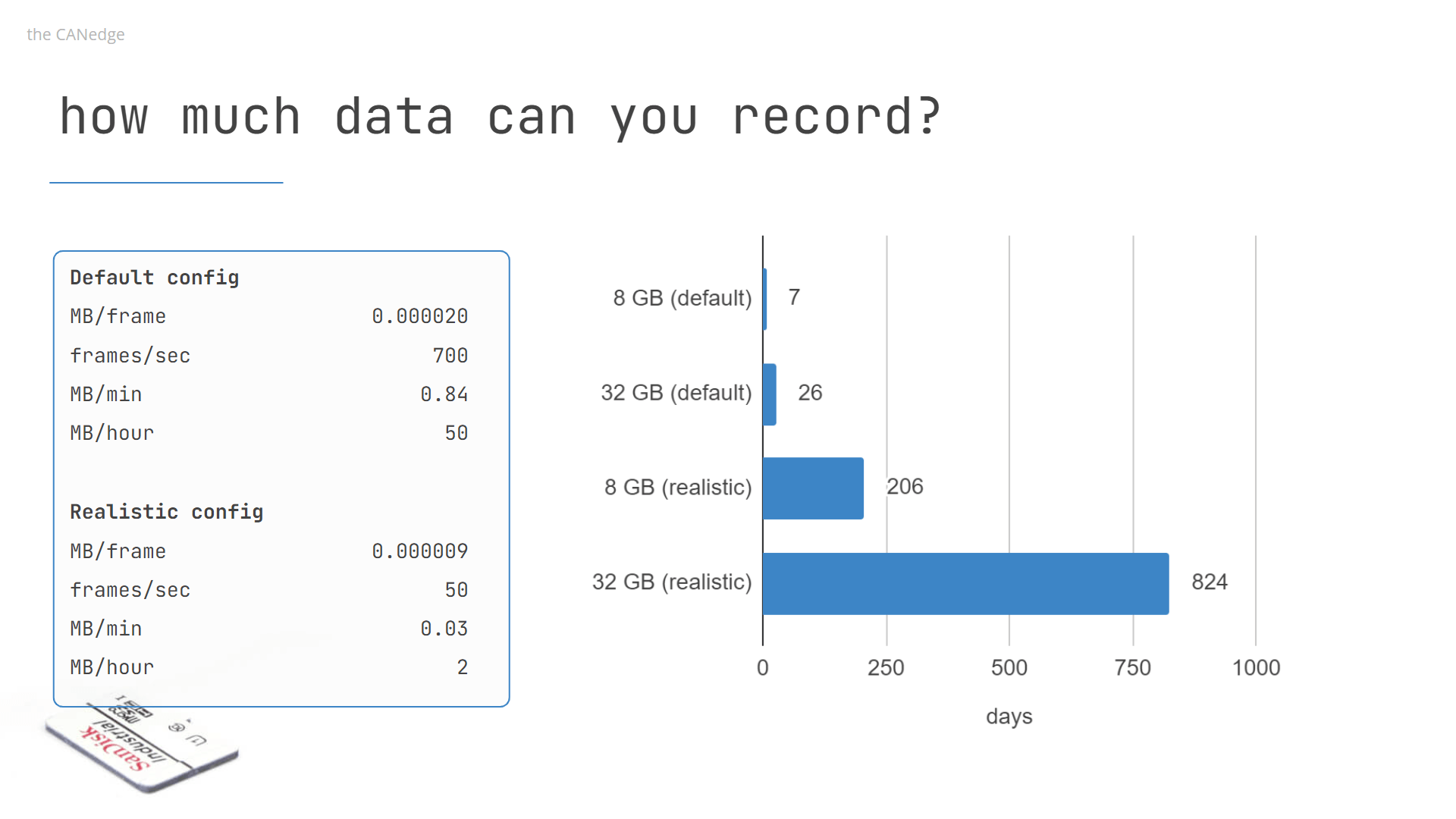
Below we list some of the key features that let you optimize your logging:
- Compression: Enable compression to reduce the data size by 50-80%
- Filters: Specify which CAN IDs to record/ignore (via ranges and masks)
- Prescalers: Instead of recording frames at their 'raw' frequencies, you can customize the frequency by CAN ID
- Control signal: Specify when to start/stop logging based on specific CAN signal thresholds
If the SD is full, cyclic logging lets the CANedge CAN logger continue recording data by deleting the oldest log files first.
For an overall intro to CAN logging with the CANedge, see our 45 min webinar (focused on the CANedge1/CANedge2).
In the below, we outline the basics of how you can start logging raw CAN data:
- Connect the CAN logger to your CAN bus (optionally using our adapter cables)
- The device powers on, detects the bit rate and starts logging raw data to the SD card
- Disconnect the device, extract the SD and insert it into your PC
- Open the raw log files in e.g. the asammdf GUI/API for DBC decoding and visualization
Next, you can e.g. set up your own server and configure the CANedge3 to connect to it to auto-upload log files. When the device is connected, it'll automatically upload log files when they are available on the SD card. Once successfully uploaded, log files are deleted from the SD card.
Note that you can use the SIM card that comes with the device - or insert your own SIM card.
For more details on getting started, see the CANedge Intro and Docs - or contact us if any questions.
The CANedge is designed to offer the best value/cost ratio in the 'pro specs' CAN/LIN logger market.
In particular, below factors differentiate it vs. similar devices:
- Pro specs: The CANedge offers specs on par with the best loggers available
- Compact: The CANedge is 50-80% smaller vs. similar devices
- Low cost: The CANedge is 50-80% lower cost vs. similar devices
- Easy-to-use: The device can be used out-the-box with no configuration
- FOSS: All software/API tools are 100% free and open source
- Interoperable: Open standards and tools enable integration into any system - with no lock-in
- Free support: We offer free best-in-class technical support
Don't take our word for it, though - check out our 50+ case studies from companies like VW, Siemens, Bosch, Cummins and more.
In addition to the above, the CANedge3 enables automatic upload of log files via 3G/4G LTE to your own server:
- SD + 3G/4G LTE: Auto-upload your data via 3G/4G LTE - and buffer them on the SD when outside coverage
- Your server: Retain 100% ownership and control of your data by uploading data to your cloud/self-hosted server
- Security: The CANedge3 enables E2E enterprise grade security
Finally, the inclusion of internal GNSS/IMU solidifies the versatility of the device.
The above makes the device an excellent choice for e.g. automotive/industrial OEM engineers.
Yes, you can use our step-by-step guide to setting up 100% free, customizable telematics dashboards for visualizing your CAN bus data in your browser. The integration uses our free Python API to DBC decode raw CAN data (from local disk or your S3 server) and push it to a time series database. From here, the data can be visualized via the popular dashboard tool, Grafana, enabling fully custom dashboards - e.g. for J1939 telematics, OBD2 telematics, marine telematics, predictive maintenance and more.
For specific examples, see below playgrounds:
The CANedge3 can upload log files to any S3 server. This includes cloud servers like AWS, Google Cloud, Wasabi, Digital Ocean and more. It also includes self-hosted open source S3 servers like MinIO.
Self-hosting a MinIO S3 server on Windows/Linux (or a Pi) is simple - see our intro. MinIO is a 100% free, open source and lightweight solution. Simply download and start it up - and you're ready to setup your 3G/4G LTE CAN bus data transfer. Note that in order to upload data via cellular to a self-hosted S3 server, the server must be 'port forwarded' so that it becomes accessible outside of the host machine's local network (see our documentation for details).
Yes, the CANedge3 3G/4G LTE CAN logger is designed for easy CAN-to-cloud integration.
For AWS, Google Cloud, Wasabi S3 and DigitalOcean the setup can be done in < 5 min as they natively support the S3 interface - letting you quickly get started with your 3G/4G LTE CAN bus data transfer.
For Azure (and other non-S3 cloud servers), you simply need to run an S3 gateway (e.g. Flexify.io) on the server. This is a bit more extensive vs. e.g. AWS/Google Cloud - but is still simple to set up.
For details, see our S3 cloud setup guide.
Generally, S3 cloud storage is low cost - and for this reason we recommend to use a cloud S3 server for most use cases as it simplifies deployment and scalability.
The cost of your cloud storage of course depends on how much data you upload - and how much you decide to retain. In most realistic scenarios where you've optimized your log file size via filters/prescalers/compression, a single CANedge would upload ~1 GB per month. Assuming you wish to retain the last year of data for each device, that means storing ~12 GB/device.
As an example, AWS S3 costs 0.023$ / GB / month - i.e. < 0.3$ / device / month for storing the latest 12 months of data.
Yes, you can easily automate your CANedge data processing through various tools:
- Python API: Our Python API lets you easily list, load and DBC decode your data (from local disk or your server). It is ideal for big data processing, database integration, predictive maintenance and more
- MATLAB: You can easily load your data in MATLAB's Vehicle Network Toolbox to leverage their data processing tools
- S3 API: You can use the S3 API to automate handling of files stored on your S3 server
To get started with automation, we recommend to check out our API examples on github.
The CANedge lets you fully customize which CAN IDs you record - and at what frequency. It also supports data compression and 'triggers' (to start/stop logging under certain conditions). Together, these features typically let you reduce your log file size by 90%+ - and it is highly recommended that you make use of them to minimize storage costs.
Due to the inclusion of internal GNSS/IMU in the CANedge, it already lets you record GNSS/IMU data.
For other sensor inputs (temperature, analog, digital, pulse, ...), you can connect external sensor-to-CAN modules to the device. In particular, our CANmod sensor-to-CAN modules can be easily combined with the CANedge.
Specifically, the CANedge 2nd port can supply 5V DC to external modules - enabling easy installation. Data from the connected sensor-to-CAN modules is recorded in the CANedge log files along with data from the other CAN/LIN channels.
Consider e.g. our CANmod.temp temperature-to-CAN module or CANmod.input analog/digital/pulse to CAN module.
The CANedge series is generally superior when it comes to logging data to the SD card vs. the CLX000. However, the CANedge does not support real-time streaming via USB. For this type of use case, we would recommend e.g. the CL2000. We may later on add new products focused on wireless real-time streaming.
No, the CANedge3 has an 8-32 GB SD card and will simply operate as a standalone CAN logger if no cellular coverage is available. For most CAN bus applications, 8-32 GB will provide several months of data capacity. Further, if the SD card is full the device deletes the oldest log files to free up space via cyclic logging.
When the 4G LTE coverage is back, the CANedge3 automatically starts pushing the accumulated log files to your server. Once a log file is successfully uploaded, it is deleted from the SD card. Note also that if the connection is lost mid-transfer, no data is lost.
The CANedge3 can split files every 10 - 86400 seconds or every 1 - 512 MB. When a new log file is created, it is automatically transferred to your server via 3G/4G LTE. As such, you can get a steady stream of incoming files - and by using e.g. AWS Lambda and our Python API, you can auto-process the incoming data in 'near real-time'.
We have various users that deploy the CANedge2/CANedge3 for near real-time upload, see e.g. this automotive predictive maintenance case study. However, setting this up for effective use requires a slightly more advanced use of the data processing tools available.
For most intents and purposes, however, we recommend to use medium/larger log file sizes (e.g. 5-20 MB) to avoid an excessive amount of log files in your server.
The CANedge3 will in most setups upload data at a rate of around 4-7 MB/minute. This is fully sufficient to enable consistent offloading of the SD card for most use cases.
For example, if you log 2 x CAN from a truck without any size optimization, you would typically generate ~1-3 MB/minute of data. In this case, you will easily be able to offload the log files even if you have periods without coverage.
Further, in more realistic scenarios, you will want to optimize your log file size via filters, prescalers, compression and triggers - see also our guide on this. Enabling such optimizations will normally result in closer to 0.01-0.05 MB/min of data being recorded.
As such, the main situation where the upload speed may become a bottle neck is if you're deploying the CANedge3 to 'record everything' for extended periods where the device is outside cellular coverage (e.g. on a maritime vessel or in a mine). Here, you will need to review how much data you accumulate during periods out-of-coverage vs. how much time the device spends in-coverage.
MQTT (Message Queuing Telemetry Transport) is a light weight messaging protocol, which is used by many IoT devices. As such, it is also supported by some cloud server IoT services for enabling e.g. statistics and analytics.
We originally considered the MQTT protocol as an option for uploading data via the CANedge2/CANedge3, but found that it is less suited for "big data" uploading. The protocol is ideal for very small packets at low resolution sent by e.g. streaming devices (with no local storage capability). However, for logging the full CAN bus load from e.g. a vehicle, the MQTT protocol would quickly get overloaded - resulting in very poor performance. For example, the protocol would make it practically impossible to "offload" all the data recorded on the CANedge3 SD card after e.g. a period with no coverage as new data would be recorded at a higher rate than it could be uploaded.
Instead, the CANedge3 utilizes the S3 REST interface with the HTTP(S) protocol. This combination is ideal for uploading large log file packets to either self-hosted servers like MinIO or cloud servers like e.g. AWS, Google Cloud and Azure. In particular, it allows for uploading data from the CANedge3 much faster rate than new data is recorded - meaning that the device can stay offline for longer periods and still offload all log files when it regains coverage.
The CANedge requires the use of a specific industrial SD card model in order to guarantee the performance and power safety. You can select an 8 or 32 GB SD card as an option during check-out (or as a separate purchase).
You should not use 3rd party SD cards as these may result in data corruption and other forms of non-functional behavior.
Yes, we actively seek to collaborate with partners - in particular 'system integrators'. The CANedge3 is designed to be easy to work with (plug & play cloud integration, open source file format, S3 interface, APIs, ...). The aim is that the device can serve as a plug & play hardware platform for companies focused on integrating the device in specific industries.
Please contact us to discuss further.
Still have questions?
Contact us


